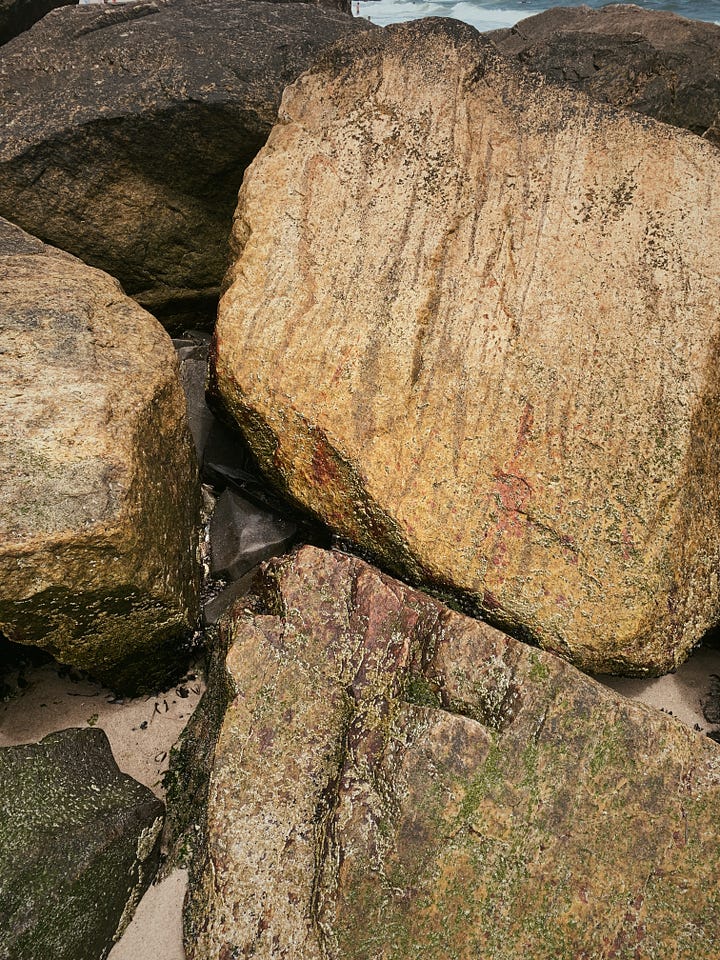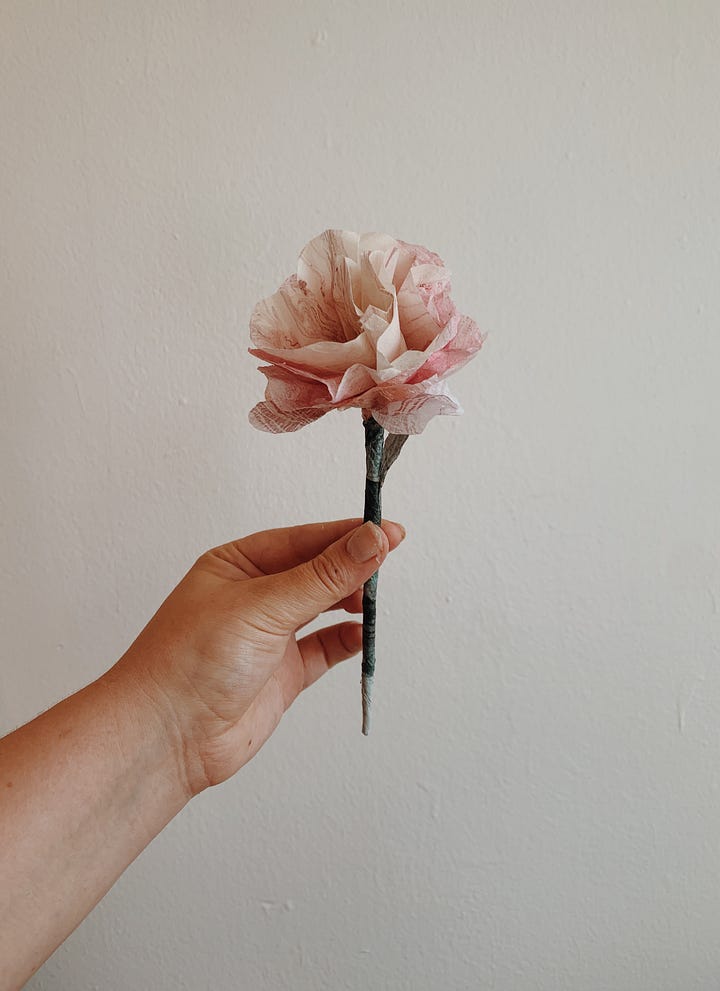I find rhythm with the linens. I’m tending to the home of the self folding towels in thirds: one, two, three. The week starts and I trace the broom like drawn an arc around the room, a line of letting go, cleaning each room around the perimeter. This is how I’m grounding down — acts of care though tending, folding, cleaning.
Time is made up of small acts of care, these practical tasks amassed as an expression of love. Tending to ourselves is a practice, a way of making a home. Make the bed, fold the towels, do the dishes, take out the trash. Open the notebook, open the lungs, make the list, write down the ideas and feelings, and breathe. Our practices are what we turn to in order to keep our minds, bodies, communities as homes, and care for them, and make them clean. Write the menu, walk to the store, make the meals, fix the salads. Repeat.
One, two, three. The first moments of daylight arrive as sunlight seeps through the blinds on the windows and into my eyelids. Wind blowing rhythms of green leaves that stretch across the horizon, obscuring the city. I attempt to slow the space between sleep and waking, so I roll over, body heavy with dream, and grab my pen. The day and the page are the same: blank. I write down dreams: a discard from the day prior. I feel into the soil of the emotional landscape to sense emotions — presence. The day ahead is blank, a horizon. I visit these terrains daily. I write and draw there.
Then, the day’s rhythm begins. Coffee, breakfast — practices I do everyday without pause. That’s the rhythm of morning, the order. Sometimes a song. To me these are the ways of grounding, ways to find my own frequency; they are the practical steps for tuning into my own strings, finding a cadence of existing.
The actions we take each day are informed by the threads of care. Sit, write, fold, cook, breathe. They are labors of loving our human forms, these simple acts inching the days forward, care in increments, not always easy. Washing a dish, folding a towel, or filling a page is a language of love spoken through the body in motion. Like love, care is a practice. A way we communicate. Within the word practical, at the root, is the word practice: an action, an act of devotion, we repeat.
To tend to the home of ourselves is a practice of care. To meditate is a housekeeping practice, a way of building a home. To write is to clean out the dust from your dusks, drawers, dawns, days whether you are tracing the terrain of your mind, riding the rivers of emotions, or making a grocery list to stay focused and ground a meal into the world. To write, breathe, meditate is a way of tending — a way of making a home, and keeping it, housed within the psyche and embodiment of our lives.
What does it mean to be warm, generous, and hospitable within our own bodies and minds? How do we tend and befriend all parts of existence? To treat our inner worlds like their own homes is a practice of building a place for us to return to within ourselves: a grounding we can retreat to when needed, a refuge in our own worlds. A way to love the self, and often a radical act. Simple, too — like writing, breathing, and cleaning — and not always easy.
I’m pulled to a memory one June almost a decade ago — purple evening, dust hills, silent halls, meditation retreat. Northern California. We had salads for lunch, soup, oats for breakfast, symphony of meals in silence. No screens, no phones, no books, no writing, no music. Seated meditation in a cool hall. Mountains off in the distance. Nature was holding us in silence as we learn the practice to be with our own nature. Our minds as hills. Minds as a landscape. We walk the hills of the landscape and learn to collaborate with the terrain, tend to it, and collaborate with it, to witness the undulations, not to excavate it. Morning sit, walking practice, afternoon. We sit, breathe, notice. Ink blue night settling evening. Longer and longer practice. Hours for the whole day. The quiet inside. Dry earth sucking up the moisture from the lungs. Practice.
At many retreats, depending on where you go, you’re given a job. These are the exchanges you make in trade for your modest arrangements: bed, meals, refuge. That summer I washed the bathrooms. I went daily to the communal spaces shared, bucket and sponge on the mirrors and the showers, cleansing the perimeters. Water in hand, circles of soap swirled, the days became clear again — a collection of collective moments washed down the drain, constellation of toothpaste washed away to near pristine reflection. At night, our teacher likened the mirror to the mind: she said that anything dusty and dirty become clear again with tending through breath, water, and practice. This the act of repeating. This is the practical practice.
How do we bridge between retreating, and being in our lives in the world? We turn our gazes up, softly, and we go slow. We remember the resonance of another and meet another’s gaze and smile, remembering that everything is a practice, and this life is a practice of remembering and forgetting, and that in the forgetting and remembering is the strength of awareness we build when we do catch ourselves, and notice ourselves, and bring ourselves back. We devote ourselves to these simple, sturdy practical acts: sitting, breathing, writing, walking, turning our attention up, repeating. We are noticing the whole horizons of our days.
When a friend visits, I find I am a magnet to these languages of caring, tending, these practical acts, something I’m learning to turn inward, too. Practices of tending are the love songs of friendship, the languages of radical care: I want to know your favorite foods, go grocery shopping, and stock the fridge. I want to fold the sheets, find the rhythm of folding the towels in thirds: one, two, three. No matter how I wrestle with gender and the domestic, this is the language that persists: a practical, grounded endeavor, where care is rhythm, and the pulse of the heart is the drumbeat. Care has a cadence that stretches and shifts to meet the need of each moment, and this is what we need. Care swells, releases, and is dynamic: sometimes simple, sometimes complex. Care is a practice. Care enough to find the root of something.
Caring and resting and cleaning can often be radical acts — radical as in the latin radix as in “root” — as in where we are rooted into, be it through what we care about, value, practice, or an environment or place. What we root ourselves into is a way of remembering, a foundation place, and like the page or the rhythms of life and the breath, something we can return to repeatedly. A practice becomes a radical act of care when it reminds us to stay with ourselves long enough to follow the threads of our suffering or our joy or our experience to the root, finding out what’s causing the rot or the expression in the first place. Sometimes I turn inward and am shocked by the tarnish, what builds up in the corners of thought and dust and mind when we are not paying attention. When I do finally clean, cleanse — let go — I’m amazed by what arrives in its place. Clarity arises.
I take myself to the ocean on Sundays. At the beach, and walking through the city, I feel home, my cells fine tuned to the rhythms of water, the timing of walking. There is salt, soft earth, horizon of sky, and possibility. By the ocean, and in the city, and in the concert of my breath, I am home and resting. Salt water, rhythm, cleansed.
What writing and walking and breathing can teach are ways to tend and befriend our inner worlds. To build a home, set the intention and return, and to welcome in your experience like a guest, to tend and strengthen, to fold and refold, to reform. May we welcome ourselves like our own friends.


PS. I may take next week off from writing — if so, visit the archive!
classes and upcoming experiences
creative practice classes in nyc and beyond
6/27 Bookbinding: Pamphlet Stitch
7/1 Suminagashi Cards
7/7 Taste + Write: Meditating on the Senses
7/8 Suminagashi Yard Party: Large Scale Marbling
7/10 Suminagashi Basics
new, in bloom this summer


Excited to share two new experiences for you — learn how to make your own marbled paper roses, or flow with ink, breath, and paper as we expand into large scale prints.
for paid subscribers,
from a past season,
To the Root
listen to the recording Sunday started with the sizzle of a squash in the oven, tending to the craving of a body (mine) asking for root vegetables. Squash, olive oil, salt, whole cloves of garlic. Oven, hot, roast for an hour. Feel where the outer layer softens. Check for color, deepening, darkened. I pull the roots from the oven.







